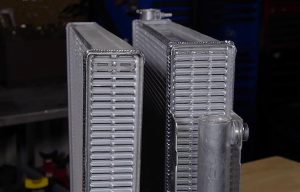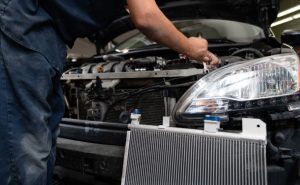High-performance engines generate significantly more heat than standard powertrains due to higher combustion pressures, increased RPM ranges, and turbocharging or supercharging. Efficient cooling is essential not only for performance but also for longevity, reliability, and safety. One of the most effective upgrades for managing elevated thermal loads is the use of multi-row radiators. These radiators feature additional coolant tubes and fins arranged in multiple layers, dramatically increasing the cooling capacity.
This article explains how multi-row radiators work, why they outperform single-row designs, and when they are most beneficial. For those looking to upgrade, you can Buy Radiator & Components online to find suitable options for your vehicle.
What Makes Multi-Row Radiators Different?

A conventional radiator typically uses a single row of coolant tubes. Multi-row radiators expand this design by adding extra layers of parallel tubes. Depending on the design, radiators may have two, three, or even four rows, each contributing to greater heat dissipation.
Key Structural Differences
| Feature | Single-Row Radiator | Multi-Row Radiator |
|---|---|---|
| Number of coolant tube layers | 1 | 2–4 layers |
| Heat dissipation area | Limited | Significantly increased |
| Coolant volume | Lower | Higher |
| Best use case | Daily driving | Performance, towing, racing |
| Efficiency under high load | Moderate | Excellent |
How Multi-Row Radiators Improve Cooling
Adding more rows does more than increase coolant volume — it enhances the radiator’s ability to absorb and dissipate heat. Below are the primary performance benefits.
1. Greater Heat Exchange Surface Area
Multi-row radiators incorporate more tubes and fins, which means the coolant has more surface area to contact. Heat transfers from coolant to metal, then to air. The larger the contact area, the more heat is removed.
Why this matters:
High-performance engines run hotter, so greater surface area ensures the cooling system can keep temperatures stable even under sustained load.
2. Increased Coolant Capacity
More rows mean more coolant volume circulating through the radiator. This helps stabilize temperatures and prevents sudden spikes during:
-
Hard acceleration
-
Long hill climbs
-
Track sessions
-
Heavy towing workloads
The increased volume allows the coolant to absorb heat more effectively before returning to the engine.
3. Improved Airflow Efficiency (Depending on Design)
Though thicker radiators can restrict airflow, modern multi-row designs use optimized tube spacing and louvered fins to maintain airflow while maximizing cooling.
Engineering optimizations may include:
-
Wider tubes to reduce restriction
-
More efficient fin geometry
-
Aluminum construction for lighter weight
These features help avoid the common problem of airflow loss in older multi-row designs.
4. Better Temperature Stability Under Extreme Loads
High-performance engines frequently operate at higher temperatures, especially turbocharged units. Multi-row radiators prevent overheating during:
-
High RPM driving
-
Aggressive throttle inputs
-
Prolonged boosting
-
Track or drift sessions
Stable coolant temperatures reduce thermal stress on metal and improve engine reliability.
When Should You Upgrade to a Multi-Row Radiator?
Drivers may consider upgrading if they experience any of the following:
-
Frequent overheating during spirited driving
-
Temperature spikes in slow traffic
-
Reduced performance due to heat soak
-
Added power through tuning, turbocharging, or supercharging
-
Regular towing of heavy loads
Vehicles That Benefit Most
| Vehicle Type | Cooling Demands | Benefit Level |
|---|---|---|
| Turbocharged cars | High | Very high |
| Performance sports cars | Very high | Excellent |
| Off-road trucks & SUVs | Moderate to high | High |
| Towing/hauling vehicles | High | Excellent |
| Daily drivers | Low | Moderate |
Pros and Cons of Multi-Row Radiators
Advantages
-
Significantly improved cooling capacity
-
Better performance in hot climates
-
Reduces risk of overheating and engine damage
-
Ideal for tuned, turbocharged, or high-output engines
-
More stable operating temperatures
Potential Downsides
-
Slightly heavier (depending on material)
-
May require enhanced airflow management
-
Higher cost compared to single-row radiators
However, for performance-focused drivers, the benefits far outweigh these minor drawbacks.
Installation Considerations

Before installing a multi-row radiator, consider the following:
-
Space availability: Multi-row units are thicker and require sufficient clearance.
-
Airflow requirements: Upgraded fans or shrouds may be needed to maintain optimal airflow.
-
Coolant quality: High-quality coolant improves thermal transfer and reduces corrosion.
-
Compatibility: Ensure the radiator matches your vehicle’s mounting points and hose sizes.
For high-quality components, you can Buy Radiator & Components online and select parts designed for your specific model.
Conclusion
Multi-row radiators represent a major upgrade for vehicles operating under heavy thermal loads. By adding additional rows of coolant tubes and fins, they deliver superior heat dissipation, increased coolant capacity, and significantly more stable temperatures — all essential for protecting high-performance engines.
Whether you drive a turbocharged sports car, tow heavy loads, or participate in track events, upgrading to a multi-row radiator can dramatically improve reliability and performance. If you’re considering an upgrade, don’t forget to Buy Radiator & Components online to find high-quality options engineered for demanding applications.